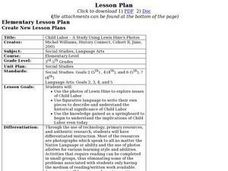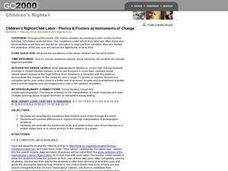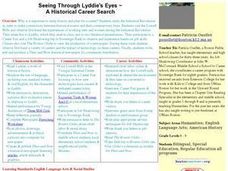Curated OER
Work, Lyddie! Work!
Students research links concerning early factory labor, child labor in today's world, and diseases on young laborers. They work on a loom, analyze a mill bell schedule, read a mill girl's diary, and write a poem or song exhibiting empathy.
Center for History Education
Methods of Reform: The Lowell Mill Girls
Although the girls and women who worked in the Lowell Mills are not often seen this way, they are the forbearers of the American labor movement. Pupils examine primary sources, including testimony about life at Lowell and labor laws, as...
Curated OER
History of American Child Labor
Students study the historical and social issue of child labor. They examine the photographs of Lewis Hine to see evidence of child labor and decide how the photographs depict the historical impact of the practice. They write a letter to...
Curated OER
International Response to Child Labor Issues
Students examine effectiveness of international response to child labor problems. Students describe problem as international community sees it, evaluate analysis and response tactics of International Labor Organization, and determine...
Curated OER
Child Labor - A Study Using Lewis Hine's Photos
Pupils use the photos of Lewis Hine to explore issues of Child Labor. They write their own pieces to describe the historical significance of Child Labor, and show the implications of Child Labor today.
Curated OER
Photographs of Lewis Hine: Documentation of Child Labor
Young scholars use the Archival Research Catalog to complete assignments and activities about Lewis Hines and the National Child Labor Committee.
Curated OER
Child Labor and Social Protest
Students explore child labor of the 1900's and compare it to its existence in countries around the world today. Several activities are included including Web research, video presentations, and group projects.
Curated OER
Early Industrialization
Eighth graders analyze primary source documents emphasizing young people in factory labor (mill workers during 1840-1860). They study hours of labor, ages of laborers, reasons for working, and working conditions. They write a poem or song.
Curated OER
Shattered Youth
Young scholars examine the state of child labor in the world. In this global economy lesson, students consider the implications of child labor in the world as they research its prevalence.
Curated OER
Children in the Fields: The Life of the Hispanic Child Laborer During California's Agriculture Explosion
Fourth graders examine the agriculture explosion in California in the late 1800's to the early 1930's. They analyze primary source material putting themselves into the shoes of a child laborer. They also gain an understanding of...
Curated OER
Children's Rights/Child Labor -- A Photographic Essay
Students continue to examine the conditions students work in throughout the world. Using photographs, they discover the similarities and differences in regions throughout the world. They relate their own experiences to the child laborers.
Curated OER
Child Labor Slide Show
Young scholars review ideas shared about the American worker while reading poems of Carl Sandburg. They now view a slide show of what they looked like. While students view the slide show, the teacher goes over information. A link is...
Curated OER
Badges of Pride
Fifth graders investigate jobs and how people identify with their job. In this labor lesson, 5th graders create a book from illustrations of various jobs. Students read an article about labor and answer questions about the article....
Curated OER
A Day in the Life of an Employed Child
Second graders compare/contrast their lives with those of children who work. They develop a generic daily schedule of their activities, compare it with the daily schedule of a child that is employed, and answer discussion questions.
Center for History Education
The Triangle Shirtwaist Factory Fire: Is Anyone to be Punished for This?
The stories of bodies falling to the pavement and girls dying in their seats echo to the present day. The New York City Triangle Shirtwaist Factory fire—which killed 147 people, mostly young women and girls—galvanized the labor movement...
National Woman's History Museum
The Triangle Shirtwaist Fire
On March 25, 1911, 146 garment workers died in the Triangle Shirtwaist Factory fire. Class members use primary source documents to research the tragedy and how it lead to the creation of labor unions and new labor laws. As an exit...
Curriculum Development Institute
Life in the Age of Machines
What was life like during the Industrial Revolution? Using a variety of activities, including writing out the dreams of laborers, industrialists, and urban dwellers, learners consider the positive and negative impacts of the Age of...
Curated OER
Children's Rights/Child Labor - Photos & Posters as Instruments of Change
Students research the use of students for labor around the globe. Using magazine pictures, they create a poster showing the various conditions they are subject to. They compare and contrast the differences in regions and evaluate the...
Curated OER
Suffer the Little Children
Students explore, examine and study about and respond to the issues of child labor workers in Guatemala by reading and discussing the article, "Bush to Press Free Trade in a Place Where Young Children Still Cut the Cane." They write an...
Curated OER
Debt Slavery and Children in Pakistan, A Case Study
Students describe extent of Pakistan child slavery problem as international community sees it, and determine whether national sovereignty is valid answer to not allowing international agencies to monitor or remedy the problems. Students...
Curated OER
Child Labor
Students examine how how groups and institutions work to meet individual needs and promote the common good, and identify examples of where they fail to do so. They describe how workers with specialized jobs and the ways in which they...
Curated OER
A Historical Career Search
Students analyze the use of language, including non-standard written and oral English. They write persuasive, descriptive, narrative and/or evaluative pieces in response to the story read and keep reflection journals. Finally, students...
Curated OER
The Industrial Revolution
Students explore what life was like during the Industrial Revolution. In this United States History lesson, students analyze a specific job then complete a webquest about that job. Once their research is complete, students work in...
Curated OER
Youth and Society
Students discuss and research what children's lives throughout the world are like and consider factors that influence living conditions. Students compare child labor laws for the U.S. and other countries and identify ideal human rights.
Other popular searches
- Child Labor 1900s
- Child Labor Laws
- 19th Century Child Labor
- American Child Labor
- Child Labor in India
- Art and Child Labor
- Child Labor Modern
- Child Labor Lesson Plans
- Child Labor in Brazil
- Child Labor Laws Usa
- Child Labor Laws 1900s
- Facts Child Labor 1900s

























